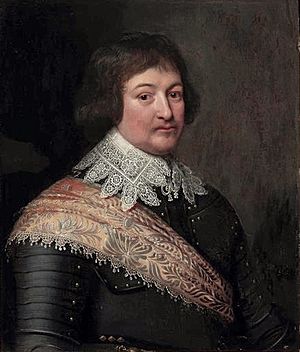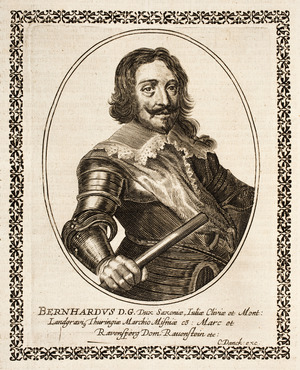Bernard of Saxe-Weimar facts for kids
Quick facts for kids Bernard |
|
|---|---|
 |
|
| Born | 16 August 1604 Weimar, Duchy of Saxe-Weimar |
| Died | 18 July 1639 (aged 34) Neuenburg am Rhein |
| Burial | Breisach, later Weimar |
| House | House of Wettin |
| Father | John II, Duke of Saxe-Weimar |
| Mother | Dorothea Maria of Anhalt |
| Religion | Lutheran |
| Signature |  |
Bernard of Saxe-Weimar (German: Bernhard von Sachsen-Weimar; 16 August 1604 – 18 July 1639) was a brave German prince and a skilled general during the Thirty Years' War. He was known for his strong leadership and his determination to fight for the Protestant cause.
Contents
A Young Prince Becomes a General
Bernard was born in Weimar, Germany, in 1604. He was the eleventh son of Johann, Duke of Saxe-Weimar, and Dorothea Maria of Anhalt. He received an excellent education and even studied for a short time at the University of Jena. However, he soon decided to focus on knightly training at the court of Duke John Casimir.
Joining the Thirty Years' War
When the Thirty Years' War began, Bernard quickly joined the Protestant side. He fought in several early battles, including Wiesloch (1622) and Wimpfen (1622). Even after some defeats, he didn't give up. He continued to fight, serving under King Christian IV of Denmark. After a tough loss in 1627, Bernard moved to the Dutch Republic. There, he took part in the famous Siege of 's-Hertogenbosch in 1629.
Fighting with the Swedish King
Bernard's military career really took off when King Gustavus Adolphus of Sweden arrived in Germany. Bernard quickly joined the Swedish army and became a colonel in the king's special guard.
Victories and Leadership
After the important Battle of Breitenfeld (1631), Bernard traveled with Gustavus Adolphus. He led many missions across different parts of Germany. He showed great bravery at the Battle of the Alte Veste. At the Battle of Lützen (1632), King Gustavus Adolphus was killed. Bernard immediately took command. He bravely led his soldiers and, with incredible energy, secured a victory by the end of the day.
Commander in Southern Germany
After Gustavus Adolphus's death, Bernard continued to lead. Sometimes he worked with his brother William, who was a Swedish lieutenant-general. Other times, Bernard commanded his own forces.
Campaigns and New Lands
In 1633, Bernard and Swedish General Gustav Horn successfully invaded Bavaria. During this time, Bernard was given control of the former areas of Würzburg and Bamberg. He was even given the title of Duke of Franconia. He put one of his brothers in charge of these new lands and returned to the fighting. Bernard was a strong Protestant. He made the Catholic cities he captured contribute money to his army. His many victories made German Protestants see him as a hero who was saving their religion. However, in 1634, Bernard suffered a big defeat at Nördlingen, losing many of his best soldiers.
Serving France and Final Victories
In 1635, France officially joined the war. Bernard then started working for France. This was a tricky situation because he sometimes followed French plans, but other times he used French soldiers to help his own goals.
Great Successes on the Rhine
Bernard's most impressive military achievements happened in the Breisgau region, near the upper Rhine River. In his major campaign of 1638, Bernard won important battles at Rheinfelden, Wittenweiher, and Thann. He also captured several strong cities, including Rheinfelden, Freiburg, and Breisach. Breisach was considered one of the strongest fortresses in Europe! Bernard had been promised control of Alsace and Haguenau by France. He hoped to make Breisach the capital of his new duchy.
His Final Days
Sadly, Bernard's health began to get worse. He died in Neuenburg am Rhein in 1639, right at the start of a new campaign. The governor of Breisach, Jean Louis d'Erlach, was later convinced to give the fortress to France. Bernard was first buried in Breisach. His remains were moved to Weimar 16 years later.
See also
 In Spanish: Bernardo de Sajonia-Weimar para niños
In Spanish: Bernardo de Sajonia-Weimar para niños



